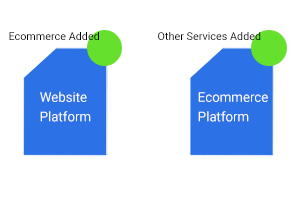Ten or 15 years ago many of the companies selling goods and services online would have described their ecommerce software as a “shopping cart.” Now, changes in software development could bring the term back.
As ecommerce has changed, so has the software used to conduct business. It has evolved from a simple add-on meant to process payments to a central hub for digital commerce.
Interestingly, omnichannel commerce may reverse this trend.
3 Phases of Ecommerce Software Evolution
For the sake of explanation, let’s describe three discernible, evolutionary phases for ecommerce software and associate those phrases with the terms “shopping cart,” “ecommerce solution,” and “ecommerce platform.”
- Shopping cart. Only processes transactions.
- Ecommerce solution. Does everything needed to run an online store, and is relatively easy to use.
- Ecommerce platform. Manages core “ecommerce” functions like the product catalog, sales reporting, and processing transactions. Also acts as a hub to integrate other software.
These phases or eras overlap and the divisions are not perfectly clear. But, nonetheless, it helps us think about ecommerce software.
The Shopping Cart Era
When Amazon and eBay were getting their start in 1995, ecommerce software was often a simple script added to an existing website to process payments.
In the shopping cart era, you needed to understand (or hire) basic web markup and JavaScript to implement ecommerce. You would need to build a website, set up a database (if you were even using a database), and then integrate your shopping cart.
This didn’t work for every business that wanted to sell online.
The Ecommerce Solution Era
Before long, companies such as Yahoo and Miva started to provide specific ecommerce solutions that included all of the software needed to sell online. These solutions required relatively little technical expertise and were relatively easy to use.
Thus, all-in-one ecommerce software became more popular, and the term “shopping cart” started to make a lot less sense given that these so called “shopping carts” were housing product information, tracking inventory, processing payments, providing tools for order processing and label printing, and even enabling basic email marketing.
By the time Magento was released in March 2008, ecommerce software started to get a new name. It wasn’t a “shopping cart.” It was an “ecommerce solution.”
The Ecommerce Platform Era
As ecommerce businesses grew in volume and complexity, they needed better performance. They needed better email marketing, better online merchandising, better personalization, better order processing, and so on.
Comprehensive ecommerce solutions made it easier to get started with ecommerce, but could not deliver the best of everything.
Rather, an ecommerce software solution might be good at one or two of the tasks associated with selling online, but not all of them.
So ecommerce software transformed again, moving from an all encompassing solution to a hub or “ecommerce platform” that managed core “ecommerce features,” such as processing payments, tracking orders, storing customer accounts, and keeping the product catalog. It integrated with other software and services, too.
Ecommerce software, in a sense, had gone from being an add-on to a website platform to being the platform other services were added to.
Ecommerce software had evolved from being a script that one adds to a website to being the platform other services were added to.
Ecommerce Part of Commerce
The ecommerce industry is quite young as business segments go. As mentioned above, Jeff Bezos launched Amazon.com in 1995, the same year that Pierre Omidyar started eBay (then called AuctionWeb).
In less than 25 years, ecommerce has grown to represent trillions of dollars in sales worldwide.
Retail ecommerce sales continue to grow, from roughly $1.5 trillion in 2015 to a projected $4 trillion in 2020, according to eMarketer.
eMarketer estimated that retail ecommerce sales will reach $2.35 trillion globally by the end of 2017 and grow to about $4 trillion by 2020. Business-to-business ecommerce sales, moreover, could quadruple business-to-consumer, retail sales.
Along with ecommerce’s rise there has been a trend to omnichannel commerce.
Omnichannel commerce recognizes that consumers control the buying process and seeks to remove the barriers between potential customers and the way in which they shop.
Omnichannel doesn’t think of ecommerce and in-store commerce as separate things, but rather as two sides of the same coin.
Sales are sales regardless of whether they are made on an ecommerce-enabled website, on an online marketplace, via a mobile app, or at a pop-up shop in Times Square.
The omnichannel philosophy doesn’t think of ecommerce as a hub or a platform, but rather as one sales channel extending from a desire to provide a better customer experience.
This philosophy is impacting ecommerce software. For at least some companies, it does not make sense for an ecommerce platform to house product and customer information that needs to be shared with so many other systems, such as physical point-of-sale setup or a marketing automation provider.
Ecommerce software’s role may need to change again.
The Return of the Shopping Cart?
At present, we are still firmly in the ecommerce platform era. Even the most omnichannel-inspired businesses still tend to have a separate ecommerce platform that they connect with their management software or other systems.
This could change. Software development has come a long way. Developers have tools like NoSQL databases, static site generators, application programming interfaces, GraphQL, and amazing frameworks like Laravel and React.
It has become relatively easy to build a product information manager (PIM) to feed an ecommerce website, a marketplace, and a point-of-sale system. It makes a lot of sense to use a headless approach to content management systems, and generate static product pages that load very quickly.
In this present golden age of software development, it is feasible that ecommerce software will return to simply processing payments. We may even start calling it a shopping cart again.

